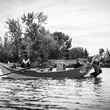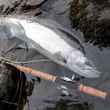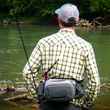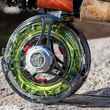Do you want to hit the jackpot when you’re on the river? Then you’d better deal yourself the right cards.
Card #1: Fish Close
There’s an old golf saying that also applies to trout fishing. “Drive for show, putt for dough.” Loosely translated, that means you should concentrate on short casts if you really want to maximize your angling success. Sure, those super-long casts look great — “Wow, Earl, that guy just threw his entire line and 20’ of backing!” — but looks can be deceiving. Top anglers invariably do their best work in tight, and that basic tenet — which holds true for dries, nymphs and even streamers — should factor into every element of your fishing. Optimize your gear for casts in the 20’ to 50’ range, and concentrate on the water close to you, rather than trying to throw your line to the other side of the river.
Card #2: Presentation Is Everything
You can make the perfect cast with the perfect fly, but if your presentation sucks you’re in serious trouble. You need your fly to mimic the naturals, regardless of whether those naturals swim, skitter or float along without a care in the world. If you’re aiming for a drag-free drift with your nymphs, then you’d better know how to mend the line. If you’re fishing dry flies, then you’ll need a reach cast in your quiver. If you’re slinging streamers, then line handling and manipulation are key for a perfect cross-current swim. You’ve heard of matching the hatch, right? Well, that means matching the natural’s action (or lack thereof) as well.
Card #3: Setting The Hook
Let’s face it. The grab is everything but it’s way better if the hook grabs back. With nymphs, slow and steady rarely wins the race. Be quick. The quicker, the better. With streamers, the hook set depends on the style of fishing. Dead drift, or a slow retrieve? Quick and hard usually makes the most sense. Fast retrieve? A strip set works just fine if the trout hasn’t already hooked himself. With dry flies, if you’re downstream of the fish, be quick. You want to pull that fly back into his mouth. If you’re upstream, or across current, you need to wait until Mr. Trout has closed his mouth before you set. Just don’t wait so long that he spits out your fly. Long story short, adjust your hook set to the situation at hand and your odds for success will go way, way up.
Card #4: Freedom Of Choice
Depending on which flies you tie or purchase, you have an almost infinite number of fly choices available to you. Sadly, when the correct fly is less than obvious, far too many anglers opt for an uneducated guess or a game of “eenie, meenie, miny, moe” - which is one reason why so many anglers fail to catch fish on a regular basis. Here’s a news flash. Everything around you is telling you which fly to use. The water type and temperature, along with the season and the weather, are akin to a Facebook post with tomorrow’s winning lottery ticket number. Seriously, look around. Is it sunny? Is it cloudy? Is the water clear or off-colored. What bugs should be hatching? Do you see them? If so, are the fish eating them? Are there baitfish or leeches or scuds in the general vicinity? Read the water and then look for clues, both obvious and less-than-obvious, before you choose your fly of the moment.
Card #5: Tip Your Hat To Wee Willie Keeler
More Like This
Back in the day, one of the great baseball players of his generation, Wee Willie Keeler, had a wonderful motto: “Keep your eye on the ball and hit ‘em where they ain’t.” That’s great advice from a guy who hit .345 over the course of his career, and it turns out that the converse of that statement is not only helpful, but also incredibly relevant, to anyone who loves to fish. “If you want to be successful, fish where the trout are.” I can’t tell you how many times I’ve seen folks fishing waters where the best angler on the planet would get skunked. This is one of those points that’s so obvious that most people overlook it, but if you’re going to fish for trout, pick a spot where there are plenty of trout in the general vicinity, and where the conditions will lend themselves to your success rather than your failure.
































Comments